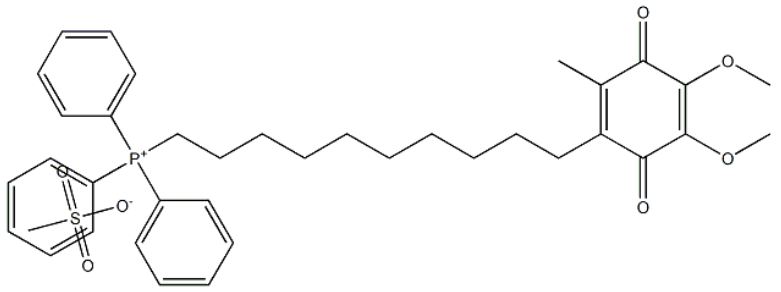Mitoquinone mesylate CAS#: 845959-50-4; ChemWhat Code: 1239761
Identification
| Patent Information | ||
| Patent ID | Title | Publication Date |
| US2007/161609 | Use of mitochondrially targeted antioxidant in treatment and prevention of drug-induced liver disease | 2007 |
| WO2005/19232 | MITOQUINONE DERIVATIVES USED AS MITOCHONDRIALLY TARGETED ANTIOXIDANTS | 2005 |
Physical Data
| Appearance | Reddish brown paste |
| Solubility | Soluble in dimethyl sulfoxide. |
Spectra
| Description (NMR Spectroscopy) | Nucleus (NMR Spectroscopy) | Solvents (NMR Spectroscopy) |
| Chemical shifts | 1H | chloroform-d1 |
| Chemical shifts | 31p | chloroform-d1 |
| Description (Mass Spectrometry) |
| high resolution mass spectrometry (HRMS), spectrum |
| liquid chromatography mass spectrometry (LCMS), time-of-flight mass spectra (TOFMS), electrospray ionisation (ESI), spectrum |
Route of Synthesis (ROS)
| Conditions | Yield |
| With oxygen; Nitrogen dioxide In dichloromethane at 20℃; for 4 – 8h; | 94% |
Safety and Hazards
| Pictogram(s) |  |
| Signal | Warning |
| GHS Hazard Statements | H302-H315-H319 Information may vary between notifications depending on impurities, additives, and other factors. |
| Precautionary Statement Codes | P501-P270-P264-P280-P302+P352-P337+P313-P305+P351+P338-P362+P364-P332+P313-P301+P312+P330 (The corresponding statement to each P-code can be found at the GHS Classification page.) |
Other Data
| Transportation | NONH for all modes of transport |
| Store in cool & dry place, keep away from strong light and heat. | |
| HS Code | 294200 |
| Storage | Store in cool & dry place, keep away from strong light and heat. |
| Shelf Life | 2 year |
| Market Price | USD |
| Druglikeness | |
| Lipinski rules component | |
| Molecular Weight | 678.827 |
| logP | 9.933 |
| HBA | 7 |
| HBD | 0 |
| Matching Lipinski Rules | 2 |
| Veber rules component | |
| Polar Surface Area (PSA) | 118.18 |
| Rotatable Bond (RotB) | 15 |
| Matching Veber Rules | 1 |
| Use Pattern |
| Mitoxantrone Methanesulfonate is primarily used for cancer treatment. It is an antineoplastic (anticancer) agent classified as an anthraquinone antibiotic. The primary therapeutic uses include : Breast Cancer : Mitoxantrone is often used to treat advanced or metastatic breast cancer. Prostate Cancer : Particularly effective in treating hormone-refractory prostate cancer. Leukemia : It is used to treat certain types of leukemia, such as acute myeloid leukemia (AML). Lymphomas and Other Solid Tumors : Mitoxantrone may also be used in the treatment of certain lymphomas and other types of solid tumors. Multiple Sclerosis (MS): Mitoxantrone is occasionally used to treat relapsing or progressive forms of multiple sclerosis to slow the progression of the disease. This drug works by interfering with DNA synthesis and replication, thus inhibiting the growth of cancer cells. |
Buy Reagent | |
| No reagent supplier? | Send quick inquiry to ChemWhat |
| Want to be listed here as a reagent supplier? (Paid service) | Click here to contact ChemWhat |
Approved Manufacturers | |
| Want to be listed as an approved manufacturer (Requires approvement)? | Please download and fill out this form and send back to approved-manufacturers@chemwhat.com |
Other Suppliers | |
| Watson International Limited | Visit Watson Official Website |
Contact Us for Other Help | |
| Contact us for other information or services | Click here to contact ChemWhat |



